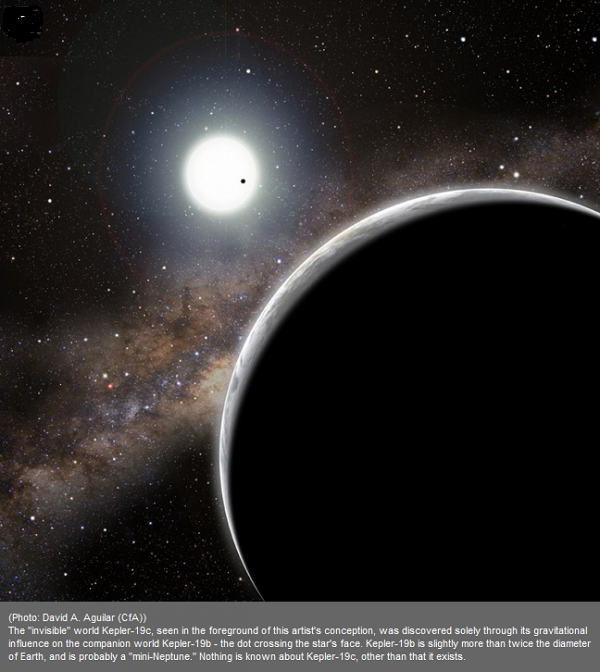Astronomers Discover 'Invisible' Planet With New Technique

Scientists have discovered an “invisible” planet for the first time by observing how its gravity affects the other planet in the system.
The invisible planet, named Kepler-19c, was uncovered when researchers from NASA's Kepler spacecraft spotted that a known planet, Kepler-19b, starts the transit early and ends late in its orbit, suggesting that a second “invisible” world tugs on it.
According to scientists, the planet Kepler-19c that comes after Kepler-19b, cannot be seen, but it makes itself known by the way it influences the other planet through its gravitational pull. The invisible planet has tugged at the Kepler-19b, slowing it down and then speeding it up in its transition.
This invisible planet makes itself known by its influence on the planet we can see, said astronomer Sarah Ballard of the Harvard-Smithsonian Center for Astrophysics, lead author on a new paper published in the The Astrophysical Journal.
It's like having someone play a prank on you by ringing your doorbell and running away. You know someone was there, even if you don't see them when you get outside, she added.
Both the seen and unseen planets were discovered by the Kepler spacecraft and orbit a Sun-like star named Kepler-19, which is located 650 light-years from Earth in the constellation Lyra. The 12th-magnitude star is well placed for viewing by backyard telescopes on September evenings in the northern hemisphere.
Kepler locates planets by looking for a star that dims slightly as a planet transits the star, passing across the star's face from our point of view. Transits give one crucial piece of information - the planet's physical size. The greater the dip in light, the larger the planet relative to its star. However, the planet and star must line up exactly for us to see a transit.
Kepler-19b transits its star every nine days and seven hours. It orbits the star at a distance of 8.4 million miles, where it is heated to a temperature of about 900 degrees Fahrenheit. Kepler-19b has a diameter of 18,000 miles, making it slightly more than twice the size of Earth.
The short orbit of Kepler-19b makes it easy to detect the effect of the nearby planet. If the planet were alone, each transit would follow just nine days and seven hours. But a five-minute delay in its orbit signals a significant outside gravitational pull on Kepler-19b, alternately speeding it up or slowing it down.
Scientists discovered the planet Neptune in the same way. Astronomers tracking Uranus noticed that its orbit didn't match predictions. They realized that a more distant planet might be nudging Uranus and calculated the expected location using telescopes.
Researchers said this is the first time this method has been used to detect an unseen planet and no other technique could have discovered the hidden world.
This method holds great promise for finding planets that can't be found otherwise, stated Harvard astronomer and co-author, David Charbonneau.
Currently, the astronomers know very little about the new planet other than that it exists. They are yet to determine its weight as it currently weighs too little to be able to measure its mass.
Kepler-19c has multiple personalities consistent with our data. For instance, it could be a rocky planet on a circular five-day orbit, or a gas-giant planet on an oblong 100-day orbit,” said co-author Daniel Fabrycky of the University of California, Santa Cruz.
The Kepler spacecraft will continue to monitor Kepler-19 throughout its mission with an aim to gather more information about Kepler-19c. Future ground-based instruments will attempt to measure the mass of Kepler-19c.
© Copyright IBTimes 2024. All rights reserved.




















